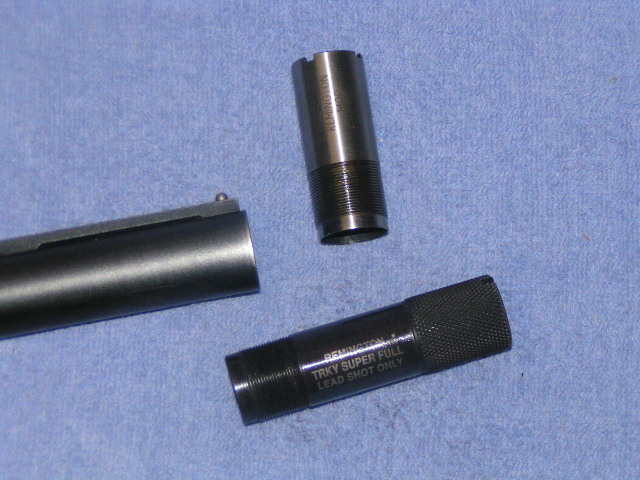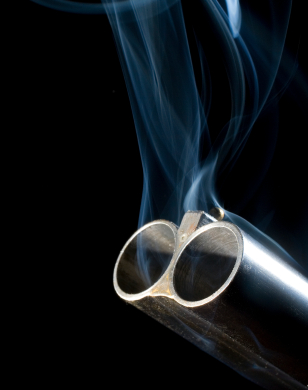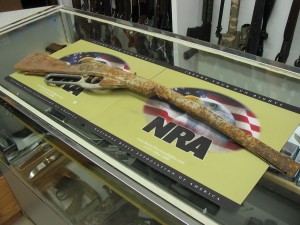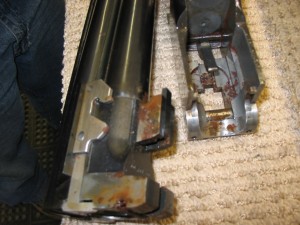Most of us take the proper storage of our firearms for granted. We use the gun, bring it home, shove it into the cabinet and ignore it until the next use. I think that every shooter has at least once in their lives has gone to their cabinet to retrieve their favorite gun and thought CRAP! What have I done! Those who haven’t, just haven’t yet! It happens to all of us.
In my 25 plus years working in gun shops I have seen some real dandy examples of storage neglect. And yes, some of them have been my own firearms. The Red Ryder in the photo might be an exaggeration of what can happen. After all, the kid that owned this BB gun decided to store it in the middle of a hog lot in Iowa. Seems he stored it there for about a year or so, maybe longer.
Most of the time what greets the gun owner is a nice coating of surface rust. This can easily be taken care of with some 0000 steel wool and oil. Dip the steel wool in some oil and gently work over the rust spots. Be careful not to use so much pressure that it removes the bluing. Sometimes the gun will need to be polished and re-blued.
Sometimes the internal damage is much worse. Keep in mind the internal parts of a firearm are made of metal also, which in turn will rust. Just last summer we had a nice Browning Citori come into the shop with severe internal rusting. The outside of the shotgun looked fine, but you couldn’t even begin to get the gun open. It was 100% rusted shut. The outside of the shotgun was wiped down after use on a rainy day and stuck back into its case for storage. It took two people three hours with hammers and punches to just get the gun apart to clean the rust out!
Moisture is the number one enemy of a firearms finish. Obviously moisture can build up from rain or snow, but it will also build up in cold weather from condensation as cold steel warms inside the home. In the summer months sweaty hands will raise heck with a guns finish just as quickly.
The best thing to do with a wet gun is to let sit in the open air in a warm place until the steel has warmed to room temperature. Keeping a wet or cold gun in a case is the proverbial kiss of death! Any moisture has no chance of evaporating and getting away from the metal surfaces inside a case. During the drying process it is best to field strip the gun if possible. It is best not to field strip if you are not sure how to do this.
After the gun has warmed and dried, wipe down the metal surfaces with a thin coat of good quality gun oil, like Rem-Oil or Breakfree. Make sure the metal is warmed before doing this. Wiping down a cold gun before it warms will actually build up moisture below the coating of oil. The metal will still continue to condense and the oil will trap the moisture on the surface.
Do not over oil. The old adage of “if a little oil is good, a lot must be better” is not true. Excessive oil will trap dirt and grime inside the working parts of the gun and can cause failures in function. The dirt can also suck up moisture and cause internal rusting. It is just best to wipe down the guns surface and use a Q-Tip dipped in oil to catch what internal parts are accessible without total disassembly. Run a damp patch through the bore. If it is a gun you use regularly in harsh conditions it might be advisable to have a competent gunsmith disassemble and clean the firearm every couple of years or so.
Long term storage of a firearm should be in a low humidity area where air can circulate around it. If the gun must be stored inside a case, it is best to use one of the new cases on the market that are treated with silicone and other rust inhibitors. Both ways, the guns should be taken out periodically and the surfaces wiped down. Over time oil will dry up and leave the surface unprotected.
The old school of thought was to store guns with the muzzle down. The idea was that any excess oil will run down the barrel and not absorb into the stock. If you have oiled your gun to the point where stuff is running off you have severely over oiled it!
Another train of thought is to store the gun with the hammer down, or in a fired position. The thought here is that it would relieve the strain on the mainspring, prolonging its life. This might have been true years ago when mainsprings were handcrafted in a forge. These old springs would lose strength over the years. But today’s metallurgy is far superior to our great grandfathers, so there is no real need to do this with modern firearms. Dry firing of certain guns will cause more damage than leaving the mainspring under tension.
One old adage, “an ounce of prevention is worth a pound of cure”, does apply when it comes to firearm storage. Simple precautions can save you hundreds of dollars’ worth of restoration later.

















This raises to mind the old saying, “Out of sight out of Mind.” I know I am guilty of putting my guns away and not using them for long periods of time. This article is a wake up call to get them out and to reclean and oil them. Thanks for the wake up call